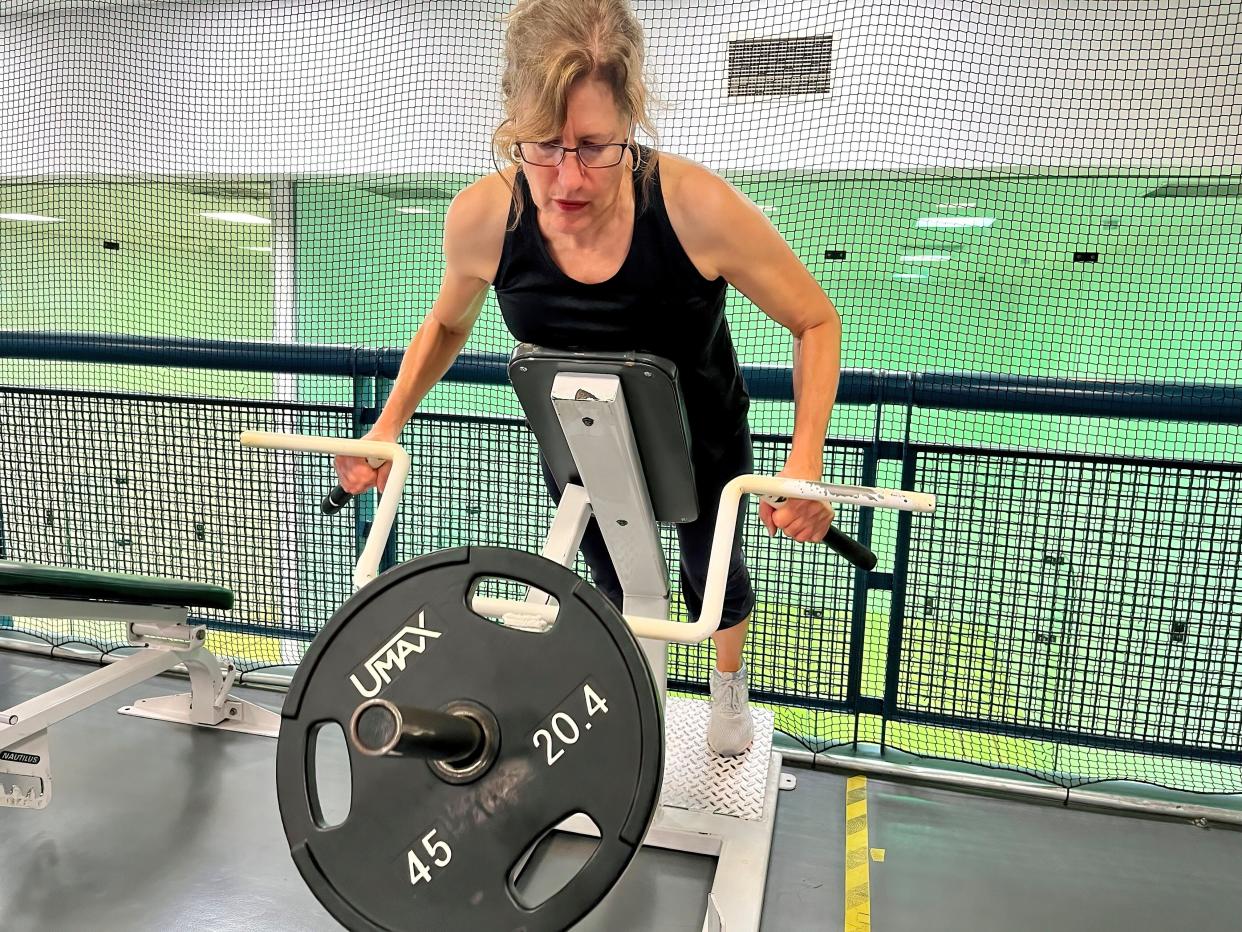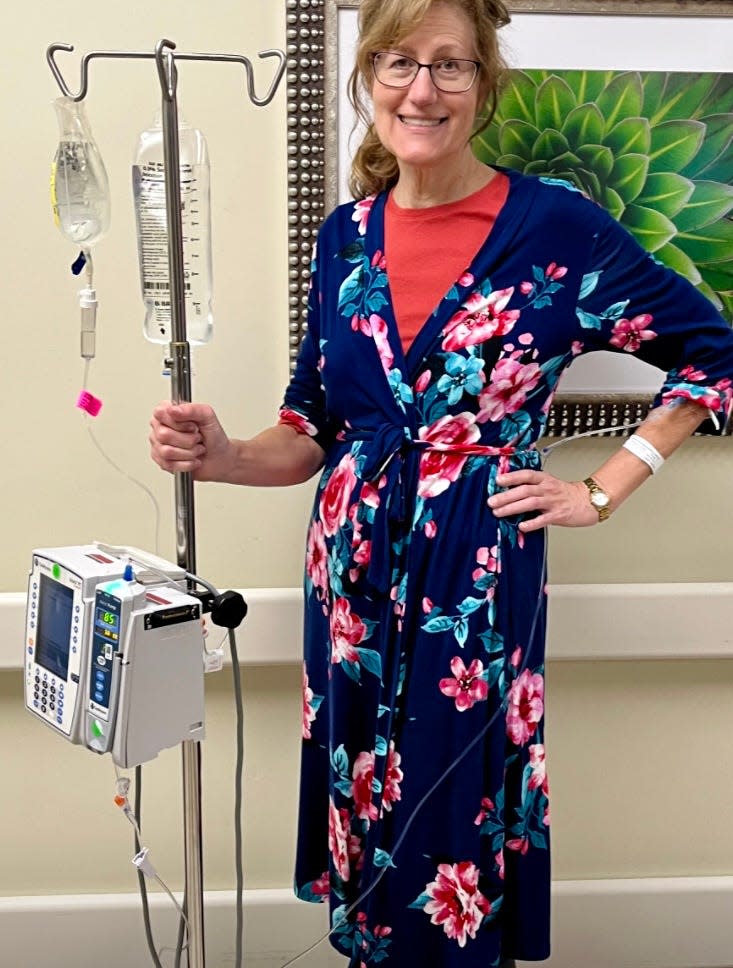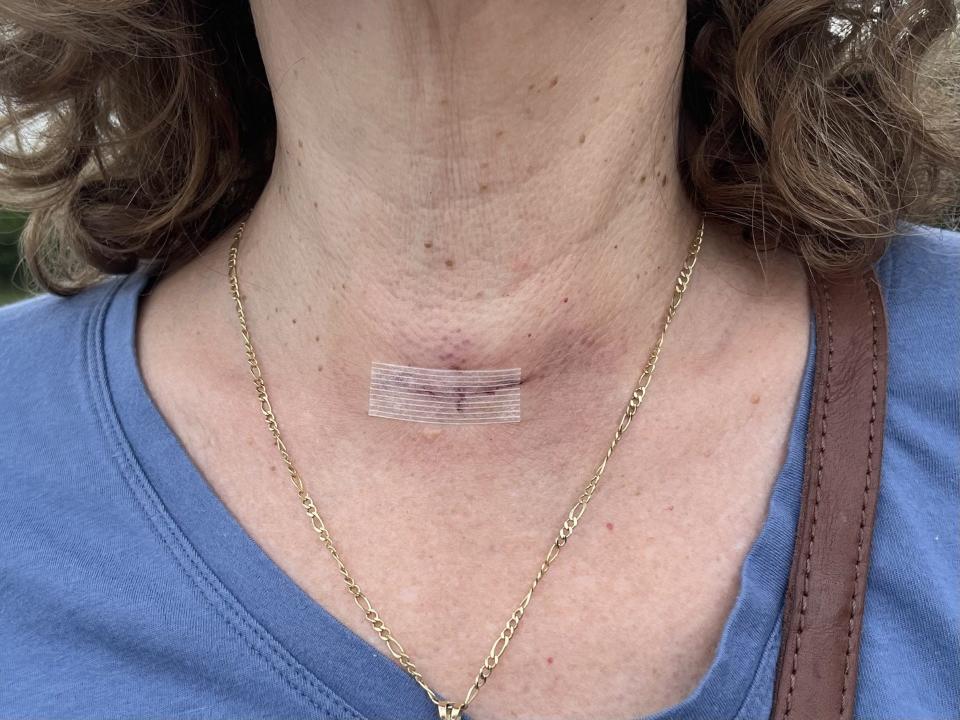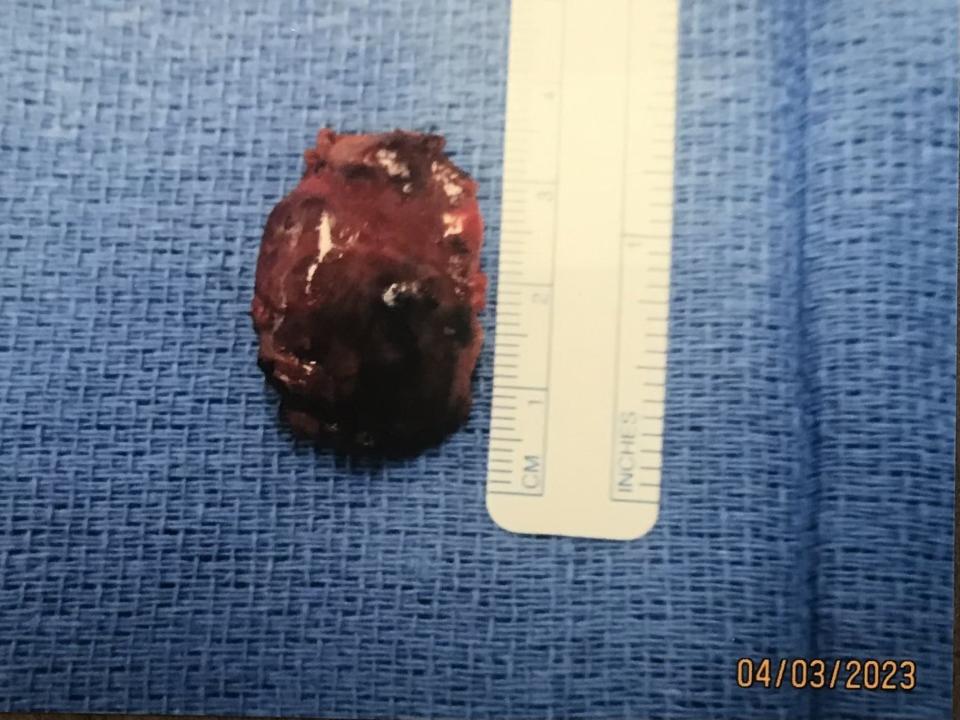First person: Ignoring my symptoms put my health in serious jeopardy

- Oops!Something went wrong.Please try again later.
“Hey, Janet, this is Dr. H. I’m sorry for calling you so late. I got a call from the lab stating that your calcium is very high. … It’s best to go to the ER. … You need to be admitted.”
What in the world? My doctor is calling me at nearly midnight on a Saturday to tell me my calcium is high? Isn’t calcium good for us? Is too much really a medical emergency?
Of course, the ringer on my phone was silenced when Dr. H made that call at 11:38 p.m. last March, so the next morning, I relied on Google.
What I was dealing with, it seemed, was hypercalcemia, something that can weaken bones. Also something usually caused by hyperparathyroidism or cancer.
More health news: Expert reveals '7 Wellness Rituals for Health, Strength & Hope'
The C word seized my attention, so I packed an overnight bag and drove myself to the hospital. (Hubby was out of town.) My spring break plans (I’m a teacher) would have to wait.
When the admitting doctor asked why I was there, I said, "Here. I'll just let you listen to this voicemail." When he heard that my calcium level was a 14.1 (normal is 8.5 to 10.2 mg/dL), he doubted my report, which he insisted must be a mistake. Anything above 12 can be fatal. (Who knew?)
No beds were available, so — despite the sense of urgency — I found myself on a gurney in a hallway from 6 a.m. until 3 p.m. Still, I was grateful to be where answers could be found.

The crystallizing power of a health scare
Health crises bring us to our knees, remind us how precious and brief life is, force us to focus on what’s truly important, and renew our appreciation for each day that’s gifted to us. Spoiler alert: I’m still here, thanks to doctors. But I nearly blew it because I don’t like going to doctors, and I haven’t always paid them heed.
I wasn’t due for my annual physical and blood work until the end of April; but for about two months, I had been nauseated, was losing weight, and was collapsing into bed as soon as I could. I almost passed out at school.
However, I had missed only one day of work, and I had mustered the energy to exercise every day, so I was annoyed that my husband kept insisting I not wait another month for a physical and blood work.
“Stoic” and “stubborn” — and, yes, occasionally “stupid” — are adjectives that have been accurately used to describe me.
Finally, I relented and got lab work done. Two days later, I was in the ER.
More: Springer's death, Menounos' survival put a spotlight on pancreatic cancer
What the ER doctor thought must’ve been a mistake turned out to be spot on. The hospital’s lab confirmed a calcium level above 14 — 14.2 to be exact.
Despite being tucked under two warm blankets, when the doctor said he was considering referring me to an oncologist, my entire body trembled.
On Day 2 of my hospital stay, an ultrasound revealed I had a large mass on my left parathyroid, a gland that sits at the base of your neck, in that divot where grandmas clutch their pearls, and where our bodies secrete hormones to regulate calcium.
What I needed was an endocrinologist, but there wasn’t one on staff, so a team of other specialists was trying to figure out what to do with me. The mass was showing up “cold” rather than “hot” under a radioactive scan. “Cold masses,” one of my doctors said, “are more apt to be cancerous.” When she left, tears rolled down my face.
A quick lesson in anatomy
I was told to get in touch with the Norman Parathyroid Center in Tampa — ASAP. After registering online, I dove into their website, downloaded their app, and became a student of my neck’s anatomy.
Turns out we have four parathyroid glands, which control the amount of calcium in our blood. About one in 100 people (one in 50 women over age 50) will develop a parathyroid tumor during their lifetime.
These tumors suck the calcium out of our bones and put it into our bloodstream: the reason for my nausea and poor appetite. How bizarre.
Fortunately, hyperparathyroidism — which can cause blood clots, stroke, heart failure, thinning bones, eye disease, kidney stones, and more — can be cured by removing the tumor.
With an IV flushing calcium out of and medication into my blood, my calcium dropped to below 12, so after four days I was released.
More from Janet Alessi: First person: How I moved from grief and guilt to holiday healing
Six days later, I spoke to one of the NPC surgeons and learned more. Parathyroid cancer is extremely rare, so he didn’t expect my mass to be malignant. On the other hand, my parathyroid hormone (PTH) levels were off the charts — 30 times what’s normal — which can be indicative of cancer.
And because my mass was so large, removing it could damage my laryngeal nerve, causing my vocal cords to become paralyzed.
Try sleeping after that phone call.
Two weeks later, before being wheeled into an operating room, I got more bad news.
A scan done in Tampa showed a large mass on my right parathyroid, whereas the scan done during my spring break showed a large mass on my left parathyroid. What? I soon learned that these scans are wrong at least 50% of the time.
The added complication of brain fog
I didn’t want to admit that my brain was scrambled, but my husband assures me it was. Cognitive impairment is in fact a symptom of hyperparathyroidism.
He says that before my surgery, the surgeon told us he knew I didn’t have parathyroid cancer. Although my PTH was nearly 400 when it should have been 10-55, even with a PTH in the thousands, the tumors are usually benign.
But this is what I heard: “Blah blah blah blah HAVE CANCER blah blah blah blah.”
My husband also heard this: Whereas most patients with two large masses have one surgery to remove both, an exception is made if the first mass encountered requires significant dissection along a recurrent laryngeal nerve.
Operating on the other nerve at the same time could result in a tracheostomy — a hole created by a surgeon just above the pearl-clutching sweet-spot so that air can be piped into a patient when the pathway is obstructed.
What I heard: “Blah blah blah MIGHT NEED ANOTHER SURGERY blah blah blah COULD END UP WITH A TRACHEOSTOMY blah blah blah.
Most parathyroidectomies (big name for removal of mostly small tumors) last 20 minutes. Mine took two hours. At least I got my money’s worth.

When I woke up, I heard my nurse saying, “I know she can hear me, but she won’t answer me, and she won’t squeeze my fingers.”
All I cared about and kept asking was, “Do I have to have another surgery?” and “Do I have cancer?” (I would like to continue to claim brain fog, but I was so irritated that she wouldn’t answer my questions, that there’s a strong possibility I was being petulant by not answering hers.)
I was so singularly focused on my questions that I forgot to be grateful that I didn’t have a hole in my throat with a tube sticking out of it and that I was able to speak, albeit weakly — something I may not have been able to do with a less experienced and skilled surgeon.
A welcome bit of good news
When my husband was allowed to see me, I finally got my answers: My surgeon had retrieved both tumors, and they were not cancerous.
“Why is she crying?” my sweet nurse — who wasn’t holding my petulance against me — asked. “Is she in pain?”
“She’s crying with relief,” my husband said.
But the guy behind the curtain next to me was in pain. When his nurse asked him to rate his post-op pain on a scale of 1-10, he said, “10.” (I gave mine a “1,” but I gauge pain levels based on giving birth without an epidural.)

True to the overachiever I am, even my tumors outperformed. While most masses removed during parathyroidectomies are the size of a grain of rice, mine were more like the size of a large strawberry.
Guided by an ultrasound, my surgeon tackled the right mass first. Because it came out quickly and easily, he moved to the left one, which was practically “cemented” to a laryngeal nerve with hard scar tissue.
He estimated my tumors had been growing for 20 years — since 2003.
This is where hindsight becomes 20/20.
In 2012, when I was 51, I didn’t have a primary physician, nor did I ever have blood work done. However, that year, the School District of Palm Beach County started charging employees an extra $50 per month for our health insurance if we didn’t get an annual biometric screening.
Saving $600 a year motivated me to do the grown-up thing and start getting yearly physicals and blood tests.
NPC says this to physicians: “Many labs show the upper limit of normal [calcium levels] being 10.5 mg/dl (2.7 mmol/L). This is the upper limit for teenagers (who are building bone). The lab is not adjusting the upper limit for the patient’s age. Take a look at your own labs, and those of all your healthy patients — we all have calcium levels in the mid 9s. It really is that simple: adults have calcium levels in the 9s, not the 10s.”
Since I began having blood work done in 2012, my calcium levels have hovered slightly over 10 — until shooting up to 14.2 this year.
Janet Alessi on dating: Too tall an order? Could dating apps deliver my true love?
The danger of not following doctors' orders
But I hadn’t gotten the memo from NPC, and — full disclosure — when I started seeing a new physician in 2018 (Dr. H), he sent me to Dr. P, an endocrinologist. But when Dr. P’s ultrasound showed nothing abnormal, my inner voice smugly said, “See, I’m fine. Why look for trouble where there isn’t any?” So, I didn’t follow up with Dr. P six months later as he requested.
As a result, Dr. P dismissed me as a patient. At the time, I was amused. I’m no longer laughing.
Perhaps my tumors were the size of a grain of rice five years ago, and I could have spared my body the trauma it has endured. In 2021 I had to have my right hip replaced: thanks to my calcium-sucking tumors?
And because my masses were so large and old, and my calcium level was so high, recovery from my parathyroidectomy has been more of a challenge than it is for most patients.
After my surgery, going from large doses of calcium in my bloodstream to no calcium would have been a shock to my system, so — as recommended — I took five calcium supplements a day, but even that wasn't enough.
If I had done my homework, I would have known that if five weren't enough, this would become apparent three days after surgery.
That third day, my lips, cheeks, and tongue were numb and tingly. That night was the longest of my life. I couldn’t sleep, I was shaking and anxious, and I felt as if I were losing my mind. When I later learned that my body was desperate for a calcium fix, I empathized with drug addicts.
Recent blood work shows that my calcium is back to normal (9.3), as is my PTH (20). And, thankfully, the bone damage caused by these tumors isn’t irreparable. Once parathyroid tumors are removed and no longer sucking calcium from our bones, almost all patients have a significant, dramatic increase in bone density.
In addition to working out with weight machines to help build my bones, I’m taking magnesium and calcium supplements with Vitamin D.
My greatest struggle has been my voice, which is improving but still weak.
What caused my body to grow those tumors? “That’s the million-dollar question,” my nurse said. The reason is known only 4% of the time.
I’m filled with gratitude for students who become doctors, surgeons who specialize in various fields and body parts, compassionate and efficient nurses, modern medicine, health insurance, scientists, innovators, teachers, hospitals, and my husband.
I’ve learned that — whereas doctors prepare us for the worst — sometimes the best possible outcome awaits us. But the first step is listening — to our doctors, to our bodies and to the people who love us.
Janet Alessi has been teaching at John I. Leonard High School since 1983 and is a frequent contributor to Accent. She can be reached at jlmalessi@aol.com.
This article originally appeared on Palm Beach Post: Janet Alessi shares how ignoring symptoms led to trip to ER, emergency surgery

